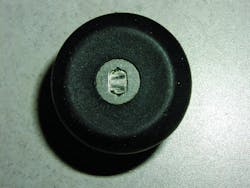In 1988 the four-door Mercur Scorpio was introduced by Ford through Lincoln-Mercury dealers. This was a model designed primarily for European markets and the most interesting feature for locksmiths was that it used a new locking system. Very early 1988 models used a Chubb locking system, but Ford quickly changed to the Tibbe system and most vehicles with Chubb locks were recalled and replaced with Tibbe.
Sales of the Mercur Scorpio were low and the model was dropped in 1990, but in that same year Jaguar began using a different version of Tibbe locks. The Jaguar system used eight cuts and three depths while the original Scorpio used six cuts and four depths. Jaguar continues to use the Tibbe system although now only as an emergency key if electronics fail.
In 2010 Ford began importing their Tibbe-equipped Transit Connect van from Europe and locksmiths were faced with re-learning how to service the six-cut Tibbe lock system (photo 1). Ford Transit Connect vans will use the Tibbe key system for 2010-2011, but may switch in 2012 to the Ford sidewinder system such as used on the Ford Fiesta.
Strattec offers two different original keys for the Transit Connect. Part 5914577 is a standard transponder-equipped key (photo 2) while the Strattec three-button 5914215 fob can be snapped into the Strattec 5914117 empty keyhead to make a fully operating remote key (photo 3).
Since Ford Transit Connects will be primarily used as commercial vehicles, key wear can become an issue. The tumblers are stamped steel and the key is nickel silver. Keys should wear faster than the tumblers. Fortunately key machine manufacturers have developed machines which make an original key instead of adding wear onto a duplicate.
Tibbe keys require a specialized cutting process. An economical route is to obtain an optional key attachment for your Framon or HPC code machine. A Framon Tibbe attachment and special cutter blade are shown in photo 5. Almost every major key machine manufacturer also has dedicated key machines which can quickly cut Tibbe keys. There are four sides to a Tibbe key and six cuts per side, so key duplication will take a few minutes.
Tibbe locks parts are very similar to an Abloy disc lock system. Each disc in the lock contains a slot cutout on its outer edge. A locking bar fits into a groove in the housing and blocks the plug from turning (photo 4). Friction washers between each disc keep the discs in parallel alignment.
The disc cutouts are arranged in 12 degree increments around the edge of the disc according to the cut 'depth' required. When a Tibbe key is inserted and turned, the discs are revolved. Discs will be revolved in 12 degree increments depending on the cuts on the key. The correct key will align all of the slots, forming a groove. Continued turning of the key moves the locking bar out of the housing groove and into the disc groove and the plug can be turned completely to the unlocked position.
Lock picking is a challenge. Several different lock picks are available such as the one shown in photo 6. Turning pressure is exerted on plug with the tip lever while each of the other levers is individually rotated with the set screws. As you 'feel' the drop-in point for each disc, the set screws are used to solidly lock that individual part of the tool in place. If the tool successfully unlocks the lock, readings can be taken on the position of each part of the tool and an operating key can be originated. Easy to describe, hard to accomplish.
A Chicagoland dealer indicated that there is a two-month wait to special order a Ford Transit Connect.
With the high price of gas, more commercial users will increasingly be sourcing smaller, economical service vehicles.






